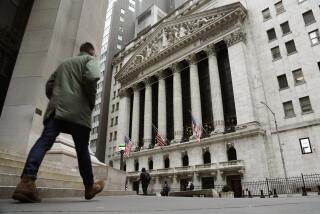Figure Slightly Above Fed Target : Revision Has 3rd-Quarter Growth Rate at 2.6%
- Share via
WASHINGTON — The nation’s economy grew at an annual rate of 2.6% during the July-September quarter, only slightly more than the earlier estimate of 2.2%, the Commerce Department said Tuesday.
Growth slowed only slightly from the 3% for the April-June period and remained above the 2.5% level that the Federal Reserve has said is the highest the nation can sustain without risking a new round of inflation.
Moreover, economists expressed fears that a slight upward revision in various measures of inflation that are factored into the GNP report would prompt the Fed to nudge interest rates up as soon as there is any hint that the economy would resume its upward march.
That view was confirmed by Lee Hoskins, president of the Federal Reserve Bank of Cleveland and a member of the Fed’s key policy-making committee.
“We’re starting to see a buildup of inflationary pressures,” Hoskins said. “If you look at prices over the last six months, you can definitely see a rising trend.”
Growth in the July-September quarter would have been even stronger--3.2%--without the depressing impact of the drought earlier this year in the Farm Belt. In the previous quarter, when the drought knocked 0.9 percentage points off the growth rate, the near-boom rate of expansion would have been 3.9%.
The somewhat slower growth rate in the more recent quarter was caused in large part by a rare drop in government purchases, paced by a steep decline in defense spending, which plummeted at an annual rate of 11.9%.
The financial markets already had anticipated that second-quarter growth would be reported at about 2.6%, and the report had little impact on stock or bond prices. Instead, the rising dollar sent stock and bond prices higher, with the Dow Jones industrial index gaining about 20 points to finish above 2,100 for the first time since Nov. 10.
Troublesome Number
Inflation rates crept up by most measures reported by the Commerce Department on Tuesday. The main GNP price index for goods and services was pushed up to an annual rate of 5.1% in the July-to-September quarter from 4.9% in the advance report a month ago. That indicator advanced 5% in the second quarter, 3.5% in the first quarter and 3.6% for all of last year.
The implicit price deflator for the national economy was raised to 4.7% from the earlier estimate of 4.4%. It rose 5.5% in the second quarter but only 1.7% in the first three months of the year and 3.3% for all of 1987.
“For the Fed, the most troublesome number here could be the upward revision in the price deflator,” cautioned David Wyss of Data Resources Inc., a economic forecasting firm in Lexington, Mass. “That still suggests some overheating in the economy and an early sign that inflation may be accelerating.”
Giulio Martini of the Sanford C. Bernstein investment firm in New York said the upward revision in the third-quarter growth estimate, from 2.2% to 2.6%, was small.
“But it was upward,” he said, “and six of the last seven GNP revisions have been upward.” In fact, he said, over the past two years upward revisions in the major statistics measuring growth--employment, retail sales, industrial production--have outnumbered downward revisions by better than 3 to 1.
“Most people pay more attention to the first report than to later revisions, so there has actually been more growth than most people think.”
Donald Straszheim, chief economist at the investment firm of Merrill Lynch in New York, pointed out that the 2.6% growth rate for the July-to-September quarter exceeded “the maximum growth rate the Fed wants to maintain price stability. I think what we’re going to see is the Fed watching very closely for the time being for any other signs of high growth, and if they find it, they’ll tighten.”
Growth Stressed
The key ingredient in any such decision, however, is most likely to be the Labor Department’s report Friday on unemployment and job creation during November.
“Markets are less interested in revisions of past data than new information, and on Friday we’ll get the first really reliable sense of what November was like,” Straszheim said.
White House spokesman Marlin Fitzwater stressed the part of Tuesday’s report that suggested steady economic growth rather than higher prices and Fed reaction. He said the GNP report did not change “the basic economic picture” of moderate growth and steady inflation.
“Inflation remains at about the second-quarter rate,” he said. “And after adjusting for the effects of the drought, the economy continues to grow at its long-term average pace, which is 2% to 3%.”
More to Read
Inside the business of entertainment
The Wide Shot brings you news, analysis and insights on everything from streaming wars to production — and what it all means for the future.
You may occasionally receive promotional content from the Los Angeles Times.








